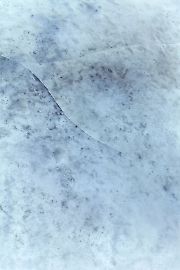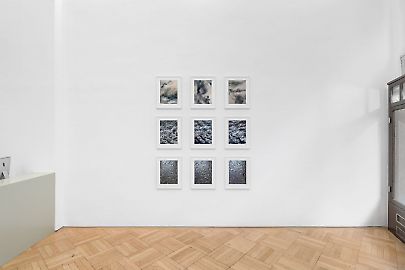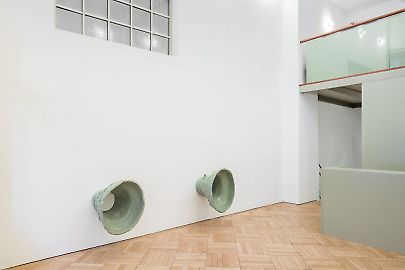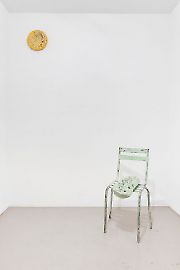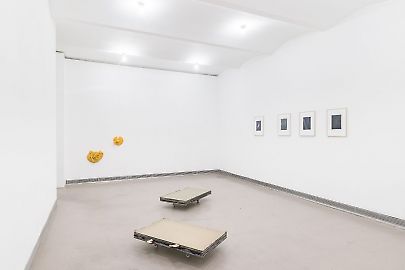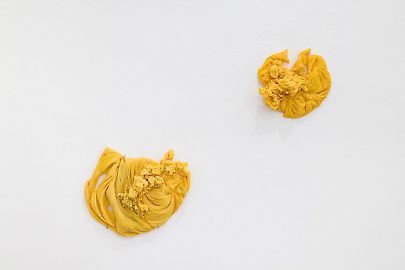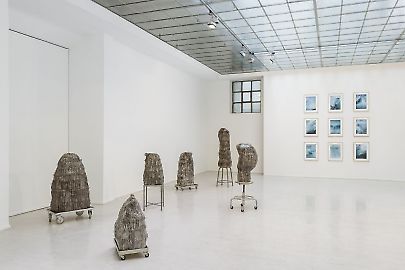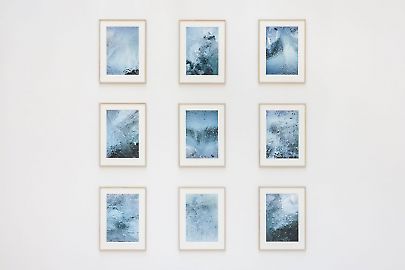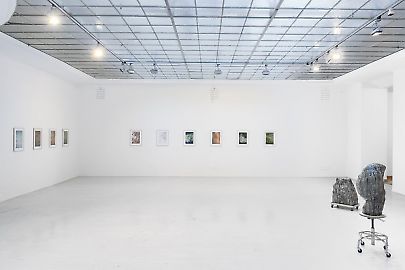Jitka Hanzlová and Marianne Mueller -- D R I F T
D R I F T
Jitka Hanzlová, Marianne Mueller
on view: March 12 – April 30, 2022
In German drift is a flow or deviation from the course on the surface of the sea caused by the wind. In English, the connotation of a general development is added, the gradual change from one situation to another: Something barely noticeable in real time that only becomes apparent when comparing one moment or state to another. A slow but steadily occurring change of traits and characteristics not caused by external influences.
The joint exhibition of Jitka Hanzlová and Marianne Mueller revolves around such changing states of organics and substance, around condensations and metamorphoses, slow erosion, around the flowing and freezing of water, the fleetingness of clouds. Concentrated moments in time captured in photography contrasted with sculpture, suggesting movement in the static. Liquid moments in the broadest sense find expression here: Water in its various aggregate states, which becomes a tableau-like surface or a solidified form.
As a fluid medium, it represents the vivid temporality observed in the current, the tides or the slowly melting ice. And yet the fleetingness of water, ice or condensation can often only be observed when captured and preserved in time by the camera. Jitka Hanzlová's series "WATER," created over a period of seven years, with its chapters "Aggregate," "Ice," "Silent Blue," "Dark Human," and "Ur," fans out what such photographs can be: projection and reflection surface, allegory. Always laid out in portrait format, they sometimes seem like portraits. These images show an element as a visual formation and penetrate the stratifications, erosions, and slices of time articulated in waves, clouds, rain, mud, ice, or even the dark fur of an animal. They are images of immense beauty, of great intensity. Their colorfulness finds almost surreal expression for the density of the ocean, the transparency of the shallow waters or the light reflecting on the surface. Jitka Hanzlová, however, remains a documentarian with a precise eye for what it is when the picture is taken. The detail frames reality and brings close what is far away: nature, ever-changing, self-sufficient, to be left untainted by man. All this unfolds in the fragile silence, without the need for a narrative.
Marianne Mueller's sculptural works are then engaged in dialogue by these visual condensations, adopting a spatial resonance. Through their volumes, they create a more abstract but no less evocative representation of matter, arresting the ephemeral despite their solid presence in space. "Phantom" is the title of a group of sculptures made of amorphous ceramics, glossy glazed, which bases, made from the frames of armchairs, stools or transport rollers, were also the pottery wheels on which the works were created. Spread in loose formation across the room, they seem like ghosts and spirits, embodiments of apparitions, essentially present and yet like traces of a memory. Marianne Mueller allows herself to be guided by the nature of the material she works with, leaving room for the randomness of the production process and creating forms that are themselves traces, temporal manifestations and figurations frozen in the process of becoming. They seem organic in their shimmering glaze or familiar despite their strangeness, like the plastic spray of beeswax cooled in icy water of "Cosmic Drift" or "Cosmic Wave". They proliferate as mushrooms, are reminiscent of loudspeakers or sensors, and embed themselves in the space that becomes their temporary habitat.
Jitka Hanzlová's images of formations frozen in ice, of grandiose cloud formations, of flow, of structure and its dissolution find a sculptural counterpart here. What becomes visible, what changes? In the coexistence and juxtaposition, an intuitive texture of references emerges, which multiplies, breaks, and is mirrored in itself. The attractive, the dangerous and the endangered lie close together. And in this cosmos of coming and passing, flowing, condensing and ultimately crystalizing, this constantly evolving biotope of density, transparency, light and color, there ultimately also arises that "drift" that sheds light on what seems obvious, and yet never is: something that we need to become familiar with again in order to understand its actual meaning.


